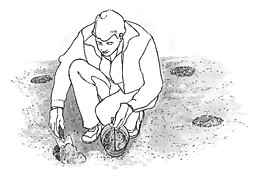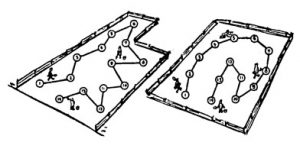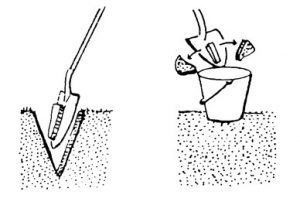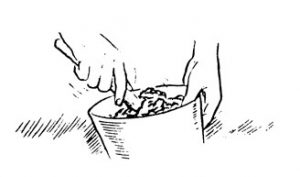
Collect samples from within the one soil type that have similar history of use. Avoid recently fertilised areas, manure and urine patches, old fence lines, old animal pens and old building sites.

Make sure your sampling tool is clean and rust free, and clean gloves are worn to reduce contamination of the soil sample.
Take multiple samples to a depth of 15 cm, from all over the area that you wish to test. In a small garden, you might take one every square metre.
 Remove the top mulch layer. Dig a hole to 15 cm deep, then take a slice of soil from top to bottom. It is very important to sample uniformly down the soil profile. Too much surface soil compared to deeper soil will give inaccurate data and may lead to inappropriate mineral amendment advice.
Remove the top mulch layer. Dig a hole to 15 cm deep, then take a slice of soil from top to bottom. It is very important to sample uniformly down the soil profile. Too much surface soil compared to deeper soil will give inaccurate data and may lead to inappropriate mineral amendment advice.
 Mix the soil sub-samples together thoroughly, in a clean plastic bucket, and then weigh out one only representative sample of approximately 450 grams. Package the sample in a plastic bag with your Name, Sample ID (e.g. veggie patch, orchard, swales) and details of the main crop to be fertilised, (e.g. lawn, vegetables, fruit trees, natives or mixed garden), on a stick on external label, (do not put the label in the bag with the soil, as it may absorb moisture from the sample and become illegible). Do not write directly on plastic, as writing can rub off in transit. Use a permanent marker.
Mix the soil sub-samples together thoroughly, in a clean plastic bucket, and then weigh out one only representative sample of approximately 450 grams. Package the sample in a plastic bag with your Name, Sample ID (e.g. veggie patch, orchard, swales) and details of the main crop to be fertilised, (e.g. lawn, vegetables, fruit trees, natives or mixed garden), on a stick on external label, (do not put the label in the bag with the soil, as it may absorb moisture from the sample and become illegible). Do not write directly on plastic, as writing can rub off in transit. Use a permanent marker.
Deliver or post the soil sample to Soil Foods.
Video on how to take a soil sample –